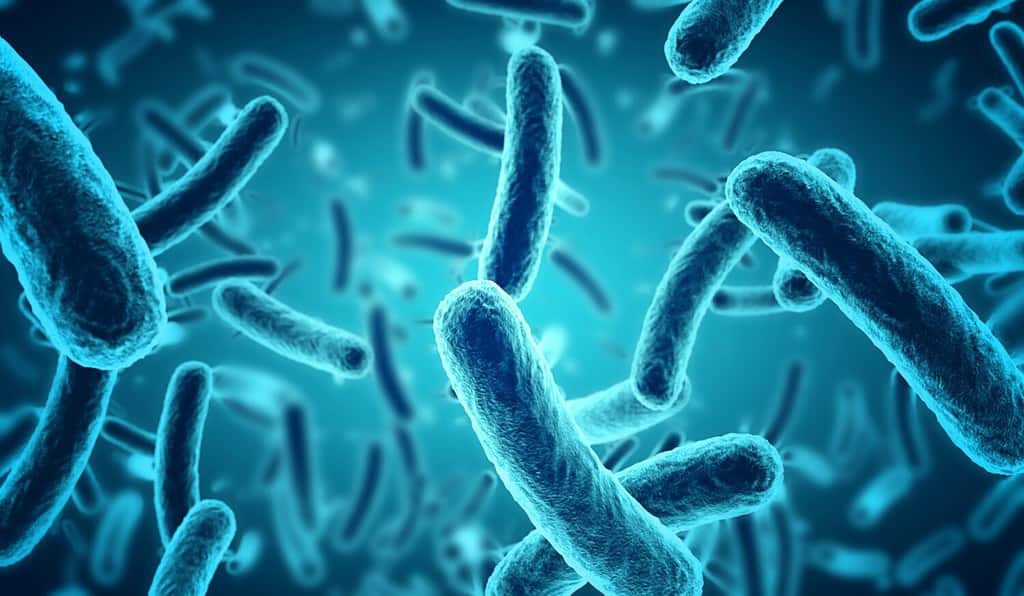Bacteria exists everywhere in the world around us, and this includes your dog’s intestines! While some bacteria are necessary and even help to maintain your dog’s gut health, other forms of bacteria can be harmful. Let’s break down the four most common intestinal bacterial infections seen in dogs!
Introduction To Intestinal Bacteria in Dogs

Digestive microorganisms play a role in facilitating nutrient absorption and promoting immune health.
©cones/Shutterstock.com
The microorganisms that exist within the canine intestinal tract make up a vast and diverse ecosystem. Close to 100 trillion microbial cells live within the canine intestine, all of which work together to maintain balance in the digestive system. Digestive microorganisms play a role in facilitating nutrient absorption and promoting immune health – two very important tasks!
Bacteria make up some of the microorganisms that exists within the digestive tract. Recent studies have revealed that most of the bacterial sequences in the canine digestive tract are from the following five phyla: Fusobacteria, Firmicutes, Bacteroidetes, Proteobacteria, and Actinobacteria.
While much of the bacteria is beneficial for the dog’s gut, there is always a risk of harmful bacteria infiltering the digestive ecosystem. Dogs can come in contact with harmful bacteria in spoiled food, in the soil, in other dog’s stool, and even in their own food and water bowls.
4 Types of Intestinal Bacterial Infections in Dogs

Dogs can come in contact with harmful bacteria in spoiled food, soil, and other dog’s stool.
©Prystai/Shutterstock.com
1. Campylobacter Infection
The Campylobacter organism is a common culprit for intestinal infections in dogs. Dogs can expose themselves to these bacteria by consuming infected stool, digging in infected soil, and even drinking from infected pools of water. Not only are Campylobacter bacteria dangerous for our canine companions, but they can also infect humans.
The most common signs of a Campylobacter infection in dogs includes mucus in the stool, diarrhea, decreased appetite, and bloody stool. It may also cause miscarriage in pregnant dogs. Antibiotic intervention can treat these bacteria, but some dogs will remain carriers even after treatment.
2. Clostridium Infection
The Clostridium piliforme bacteria leads to an intestinal infection known as Tyzzer disease. It primarily impacts the cells within the intestine, heart, and the liver. Dogs are often exposed to this bacteria by coming in contact with infected soil, plants or water sources such as streams, ponds, and lakes. It most commonly infects dogs that are experiencing any form of stress and a weakened immune system.
The most common sign of Tyzzer disease is severe diarrhea or bloody diarrhea. Other symptoms of Tyzzer disease in dogs include lethargy, vomiting, fever, and jaundice. Most dogs will require intravenous fluids and nursing care to help them recover.
Dr. Amy Nicole Lewis, a veterinarian with Worldwide Veterinary Services, told A-Z Animals that Clostridium appears to be a common culprit leading to hemorrhagic gastroenteritis in dogs, or HGE. HGE is a condition that refers to a sudden case of bloody diarrhea and vomiting in dogs, and it requires aggressive hospitalization to resolve it. HGE can be fatal if left untreated due to severe dehydration and blood loss.
3. Helicobacter Infection
Helicobacter infections in dogs are still being studied by experts, but they likely link to a variety of digestive disorders in dogs. Studies show that many dogs with inflammatory bowel disease, food allergies, and digestive cancer tested positive for the Helicobacter bacteria. However, it has not been officially linked to these issues. Helicobacter bacteria may lead to diarrhea, vomiting, lethargy, decreased appetite, abdominal pain, and other forms of gastrointestinal health decline.
4. Salmonella Infection
Salmonella is a well-known bacterium that impacts both dogs and humans alike. Most dogs come into contact with Salmonella by eating contaminated food such as raw eggs, raw meat, unrefrigerated wet food, or recalled pet food. Salmonella can lead to severe food poisoning when introduced to the digestive system in dogs. Salmonella poisoning in dogs can lead to diarrhea, bloody diarrhea, vomiting, lethargy, anorexia, weight loss, and even sepsis. This bacterium can also cause a miscarriage in pregnant dogs.
Treatment for a Salmonella infection in dogs will vary based on how severe their illness is. Some dogs will require aggressive hospitalization with antibiotics, intravenous fluids, and nursing care. Treatment is essential due to the risk of infecting the humans in their home. Salmonella is a zoonotic disease.
Symptoms Of an Intestinal Bacterial Infection in Dogs
Dogs with a bacterial infection in their intestines will often experience gastrointestinal irritation. The infection and inflammation within their gut can lead to the following symptoms:
- Diarrhea
- Bloody diarrhea
- Vomiting
- Lethargy
- Decreased appetitie or anorexia
- Weight loss
- Abdominal pain
- Weakness
- Dehydration
Take your dog to the vet if they are experiencing any of the above symptoms for more than 24 hours. While all canine friends can develop a mild case of GI upset from time to time, an upset stomach that lasts longer than 24 hours should always warrant veterinary guidance. Your vet can perform the necessary testing to determine if any of the above bacteria are to blame for their illness.
Final Thoughts on Intestinal Bacteria in Dogs
Dogs can fall victim to a variety of intestinal bacterial infections. Be sure to review the information above to better understand the bacteria that exists within your dog’s digestive system!
Ready to discover the top 10 cutest dog breeds in the entire world?
How about the fastest dogs, the largest dogs and those that are -- quite frankly -- just the kindest dogs on the planet? Each day, AZ Animals sends out lists just like this to our thousands of email subscribers. And the best part? It's FREE. Join today by entering your email below.
Thank you for reading! Have some feedback for us? Contact the AZ Animals editorial team.








